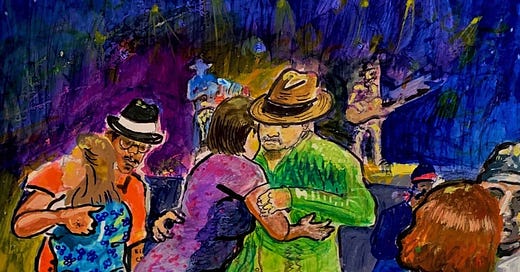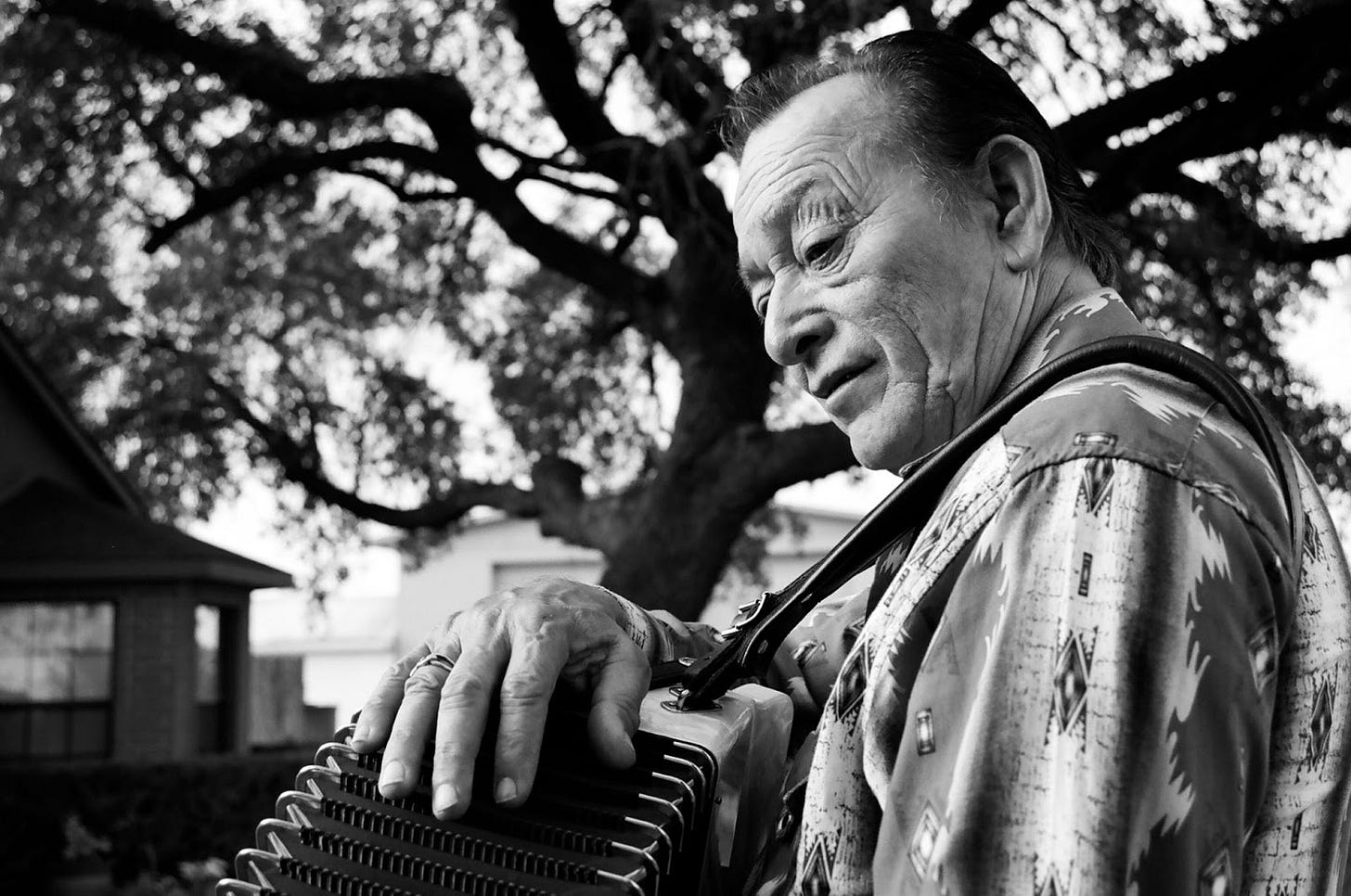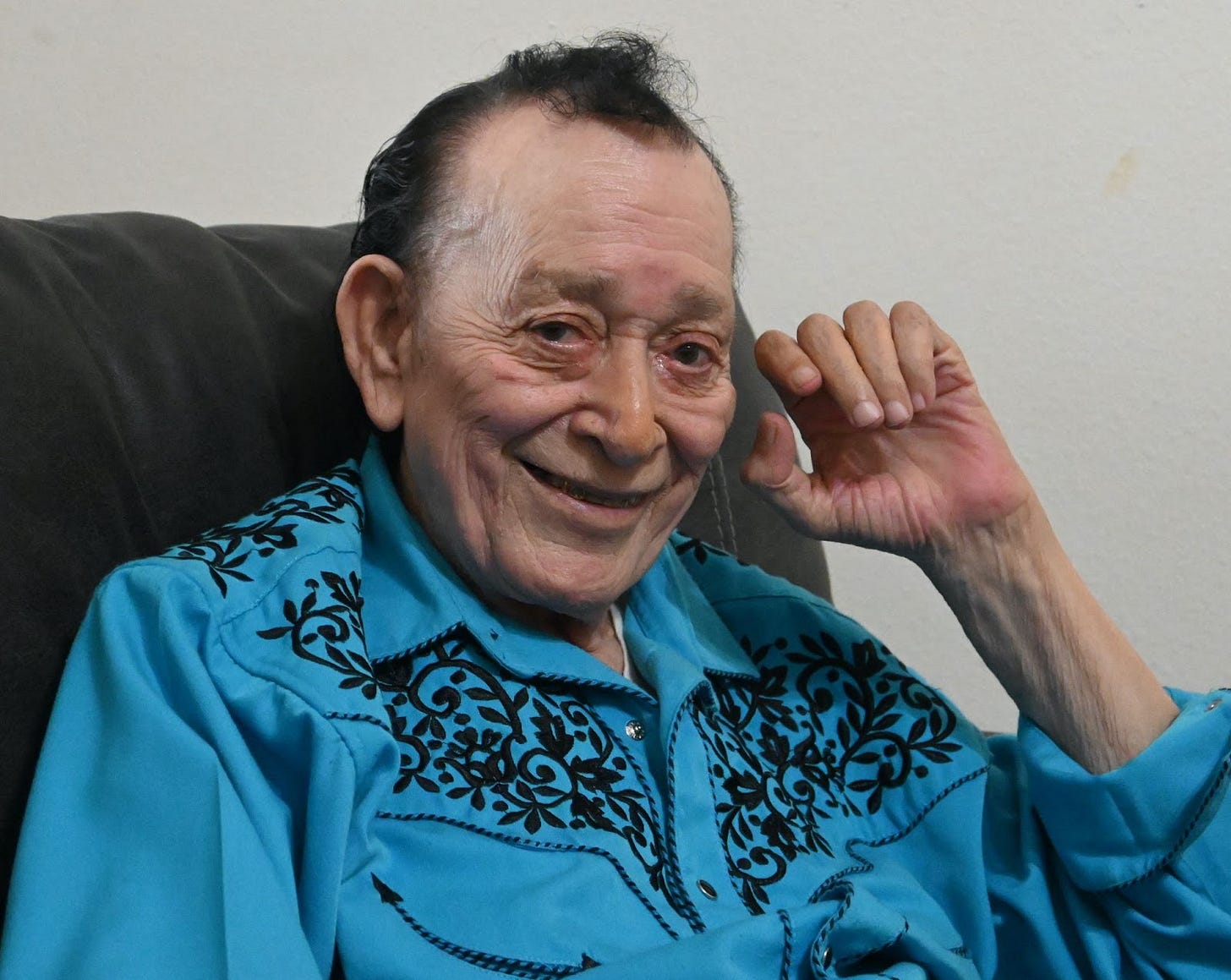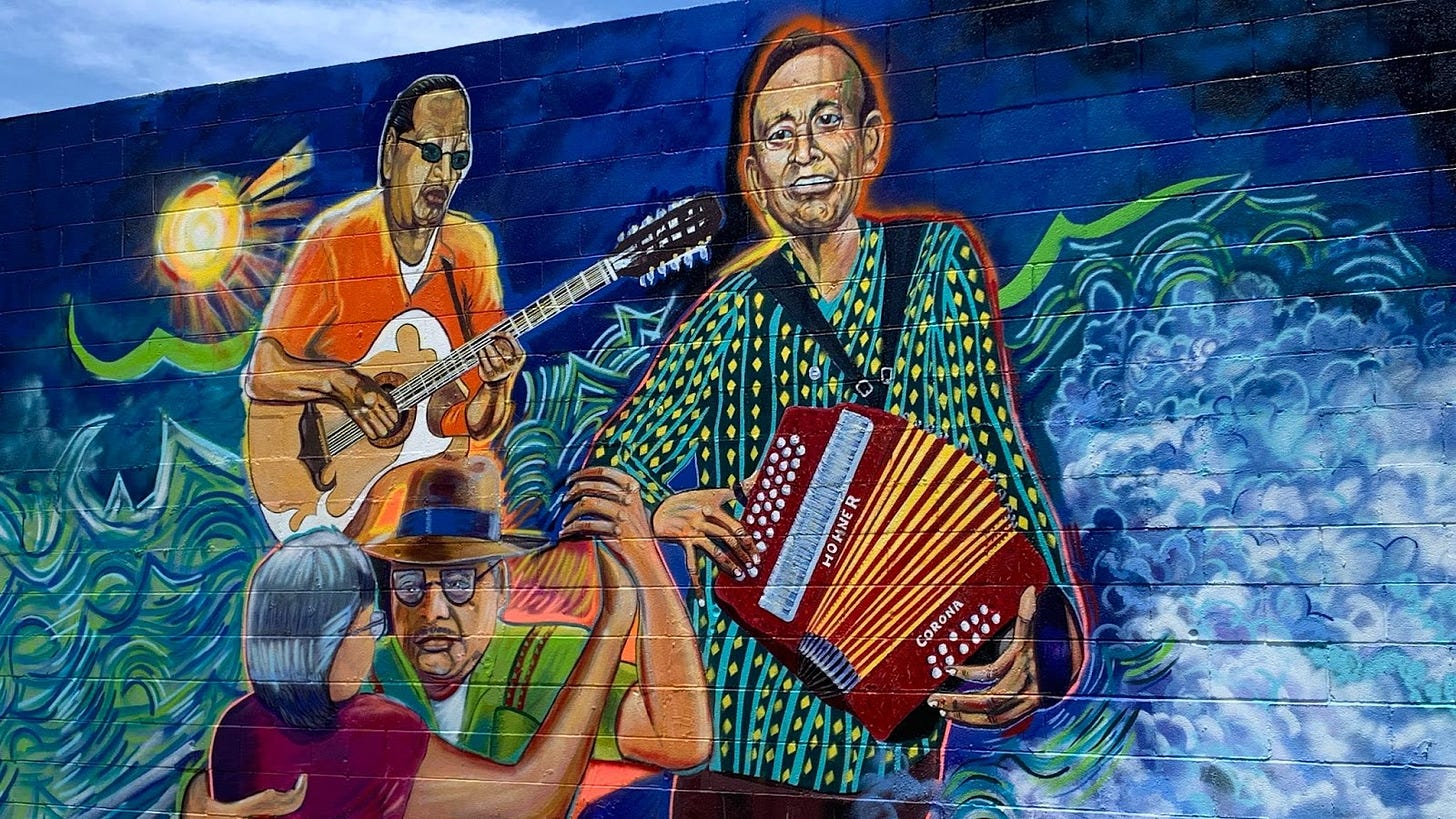Flaco Jimenez’s music journey has been as imposing as a Texas Tornado, as sizzling as a Super Seven Texas sun, and as dramatic as a rocking Rolling Stone. The magical reference in those names reveals different moments that brought Flaco Jimenez added music fame. With over 120 albums and an estimated 1500 singles, Flaco is a music studio’s dream recording machine. His many recordings and performances have won him five Grammys and a Grammy Lifetime Achievement Award. Flaco’s six decades of playing have enlivened the rich conjunto and Norteño Borderland sounds.
When Flaco plays, everyone dances. Del Rio, Texas mural by Cris Escobar. Courtesy of the artist.
Flaco grew up in a talented musical family. His grandfather, Patricio Jimenez, a native of Eagle Pass, gave Flaco’s dad, Don Santiago Jimenez, his first music lessons. Patricio Jimenez came to San Antonio as a young man and found work in the quarry adjacent to Brackenridge Park. The family lived in the “Mexican Village,” a housing camp for laborers located next to the quarry.
The musicians of that era all had day jobs and played for tips in the evenings or weekends. Many of them found receptive audiences at the Plaza de Zacate, a city park across from Farmer’s Produce Market, which is now Market Square. It was there that the famed singer, Lydia Mendoza, got her start.
Flaco loved to listen to his father play the accordion. As a pre-school child, Flaco often sat in the living room in awe as his dad wrote songs and practiced new musical scores. By age six Flaco began to practice with his dad’s accordion and bajo sexto while his father was away at work. His dad came home early one day and found Flaco playing. His dad’s tears told Flaco that his dad not only approved but that he saw musical talent in his son.
Flaco has fond memories of the day his music career began in 1947 at age eight. Flaco had gone with his dad to watch him perform at “El Gaucho,” a nightclub on El Paso Street on the Westside of San Antonio. Cruz Saenz, owner of the nightclub contracted Don Santiago in the mid-1940s, and the accordion maestro played there every weekend over the next ten years. [Full disclosures: Cruz Saenz was my uncle, the brother of my grandmother, Maria Saenz Romo, who also lived on El Paso Street]. I first went to the nightclub when I was 14, and I vividly recall the great conjunto music of Don Santiago Jimenez.
Flaco and members of his band at a backyard [East 6th Stree] Austin political fundraiser for State Senator Gonzalo Barrientos. Photo by Ricardo Romo, circa 1984.
Don Santiago played a four-hour performance in the evenings from eight to midnight. One evening the bass player suggested to Don Santiago that his son could play a few songs during the break. At age eight, Flaco felt confident enough to step in that night when his father took a short break. Joined by the band, Flaco played some of his father’s songs and received loud audience applause. A member of the band passed a collection hat afterward and gave Flaco the coins that the pleased crowd contributed in appreciation. This night marked the first earnings of his career as a musician. It was enough to buy his sisters and brothers candy treats the following day. Soon after that event, Don Santiago gave his son his famous nickname–Flaco.
Flaco, who plays both the bajo sexto and accordion, formed his band at age 15, Los Caporales. By the 1960s he had become one of South Texas’ most popular TexMex musicians. Flaco was famous in Texas, but little known nationally, and largely unknown internationally. Flaco’s friend, Doug Sahm, founder of the Sir Douglas Quintet, invited Flaco in 1973 to record with him for Atlantic Records. Music critic James Head wrote that Doug Sahm released the album “Doug Sahm and Band” with help from his friends Flaco Jimenez, Bob Dylan, and Dr. John. The album includes the popular song “Is Anybody Going to San Antone?”
Flaco by San Antonio photographer Guillermina Zabala, 2006.Photo courtesy of the artist.
Doug Sahm’s album helped Flaco gain national exposure, but Flaco’s introduction to international audiences came with his association with the famed singer and master guitarist, Ry Cooder. In the mid-seventies, Cooder invited Flaco to join him on a European tour. Cooder loved Flaco’s music and in 1976 included him in his album “Chicken Skin Music.” Flaco, in his late forties by then, was becoming the most admired and most well-known representative of TexMex music.
Every decade has had its memorable moments for Flaco. One of his more important memories of the mid-1970s occurred when a documentary film crew from California came to South Texas to produce a movie about the region’s important Norteño and TexMex musicians. The movie, “Chulas Fronteras,” brought Chris Strachwitz, founder of Arhoolie Records, and famed documentary film producer, Les Blank, to Texas. Bank filmed several TexMex and Norteño bands and singers. Among the stars of the movie were the Jimenez family– Don Santiago, his son Santiago, and Flaco. Also featured were Lydia Mendoza and the famed Norteño band, “Los Aleges de Teran.”
Flaco at his home. Photo by Ricardo Romo. August, 2022.
Music historian David Witt commented that “Chulas Fronteras” included many of the songs that are “standard tales of unrequited or dysfunctional love— Lydia Mendoza’s rendition of “Mal Hombre” and “La Nueva Zenaida” by Flaco Jiménez.” Flaco’s introduction to Strachwitz and Arhoolie Records led to the release in 1978 of the album “Flaco Jimenez & His Conjunto” and to a famous Flaco recording of “Ay Te Dejo en San Antonio” which won Flaco his Grammy in 1986.
In 1989, Doug Sahm formed the Texas Tornados inviting Freddy Fender, Augie Meyers, and Flaco Jimenez to join him. Soon after, they were signed by the prestigious recording studio Warner Brothers Reprise, and the group recorded its first album “Texas Tornados” in 1990. The popular album hit Number 5 on the country charts, and a song from that album, “Soy de San Luis,” won the 1991 Grammy for Best Mexican American Performance.
Flaco was performing in San Francisco in 1994 when he received a call from Mick Jagger of the Rolling Stones. Would he fly to Los Angeles and add a song to their album? A quick “yes” got him on a flight to the City of Angels where he recorded an accordion solo for the Stones’ upcoming album “Voodoo Lounge.” Soon after, Raul Malo of the Mavericks invited Flaco to join them in their album “Music for All Occasions.” Flaco made a notable contribution to the Mavericks’ popular rendition of “All You Ever Do Is Bring Me Down.”
Flaco’s Grammy award case. Photo by Ricardo Romo. August 2022.
Flaco joined with some of the great Latino music talents in the late 1990s when they formed Los Super Seven. The band performed to full houses with Cesar Rosas and David Hidalgo of Los Lobos and famed musicians Freddy Fender, Rick Trevino, Ruben Ramos, Doug Sahn, Max Baca, Raul Malo, and Joe Ely. Twenty years later, Flaco still performs with some of his Super Seven friends. When Flaco and I met in late August, he was preparing for an upcoming recording session.
As I listened to Flaco talk about his truly memorable music career, I realized again that I was in the presence of an amazing musical genius who has made Latinos all over the world proud of this South Texas heritage.
A tribute to Flaco. Del Rio, Texas mural by Cris Escobar. Photo courtesy of the artist.









I learned something new every time I go to this site. Thanks for the history lessons.
Flaco is a living legend. His music transcends across all genres, all over the world. He is truly a gift to all of us.